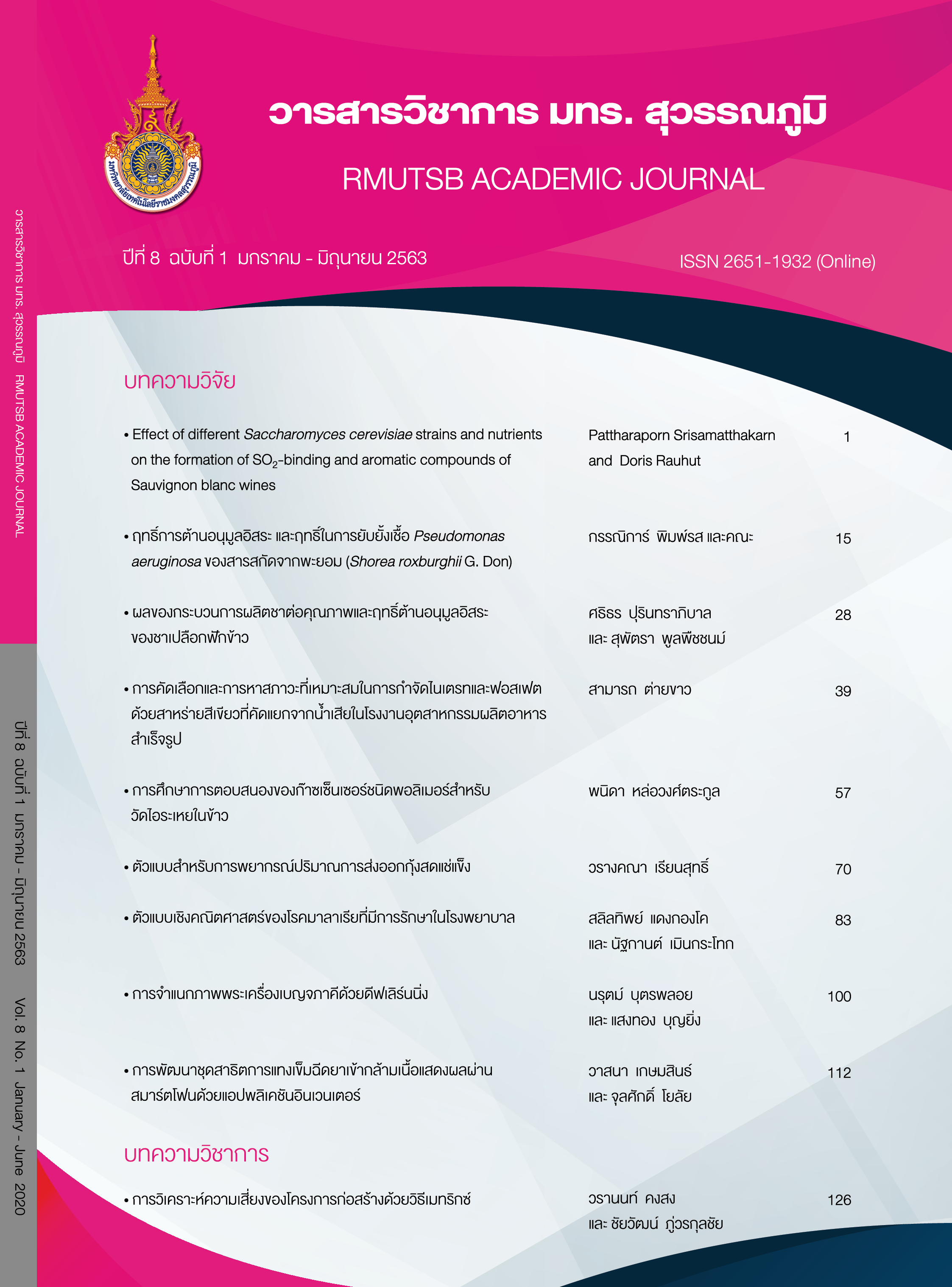Effect of tea processing on quality and antioxidant properties of gac fruit peel tea
Main Article Content
Abstract
This research investigated the effect of gac fruit peel tea process, including rolling time of gac fruit peel (10 and 20 minutes), fermentation time (1 and 3 hours), and drying temperature (50 and 60 ºC) on physical, chemical and antioxidant properties of the gac fruit peel tea. The results indicated that the rolling and fermentation times of gac fruit peel resulted to increase total phenolic contents. On the other hand, the total phenolic contents were decreased when the drying temperature was increased. The assay of antioxidant activities by 2,2’-azini-bis(3-ethylbenzothiazoline-6-sulfonic acid) inhibition or ABTS scavenging assay, and ferric reducing antioxidant power activity (FRAP) were determined. The result showed that the rolling and fermentation processes improved higher antioxidant activities of the gac fruit peel tea. The gac fruit peel tea processing by rolling for 10 minutes, fermentation for 1 hour, and drying at 50 ºC gave the highest antioxidant activities, which ABTS scavenging and FRAP values were 23.09 mg Trolox equivalent/mL and 0.49 mg FeSO4/mL, respectively. Moreover, sensory evaluation of this gac fruit peel tea showed the highest liking score for all attributes.
Article Details
Published manuscript are the rights of their original owners and RMUTSB Academic Journal. The manuscript content belongs to the authors' idea, it is not the opinion of the journal's committee and not the responsibility of Rajamangala University of Technology Suvarnabhumi
References
Ajila, C. M., Leelavathi, K., & Prasada Rao, U. J. S. (2010). Mango peel powder: A potential source of antioxidant and dietary fiber in macaroni preparations. Innovative Food Science and Emerging Technologies, 11, 219-224.
Anorach, R., & Weerapreeyakul, N. (2005). Analytical method of antioxidant activity in vitro. Khon Kean University Science Journal, 33, 13-18. (in Thai)
Aoki, H., Kieu, N. T., Kuze, N., Tomisaka, K., & Van Chuyen, N. (2002). Carotenoid pigments in gac fruit (Momordica cochinchinensis Spreng). Bioscience, Biotechnology and Biochemistry, 66(11), 2479-2482.
Bhamarapravatana, K. (2013). Gac: Food for anticancer. Bangkok: Moh-Chao-Ban Publish house. (in Thai)
Chantarangsee, M. (2015). Antioxidant and antibacterial activities of ethanolic extracts from different parts of gac fruit. KKU Science Journal, 43(3), 490-502.
Chongchaithet, N. (2011). Nutrition composition of coffee. Thailand journal of Health Promotion and Environmental, 34(4), 60-68. (in Thai)
Chuyen, H. V., Roach, P. D., Golding, J. B., Parks, S. E. & Nguyen, M. H. (2017). Optimisation of extraction conditions for recovering carotenoids and antioxidant capacity from gac peel using response surface methodology. International Journal of Food Science and Technology, 52(4), 972-980.
Ishida, B. K., Turner, C., Chapman, M. H., & McKeon, T. (2004). Fatty acid and carotenoid composition of gac (Momordica cochinchinensis Spreng) fruit. Journal of Agricultural and Food Chemistry, 52, 274-279.
Kubola, J., & Siriamornpun, S. (2011). Phytochemicals and antioxidant activity of different fruit fractions (peel, pulp, aril and seed) of Thai gac (Momordica cochinchinensis Spreng). Food Chemistry, 127, 1138-1145.
Leelamanit, W. (2014). Gac fruit. Bangkok: Department of Biochemistry, Faculty of Pharmacy, Mahidol University. (in Thai)
Maisuthisakul, P. (2006). Application of phenolic compounds from plant as free radical scavenging. University of Thai Chamber of Commerce Journal, 26(3), 222-238. (in Thai)
Nicoli, M. C., Anese, M., Parpinel, M. T., Franceschi, S., & Lerici, C. R. (1997). Loss and/or formation of antioxidants during food processing and storage. Cancer Letters, 114, 71-74.
Pajareon, S. (2019). Stability of anthocyanin extract from riceberry rice bran encapsulated with rice bran protein concentrate under different pH and heating conditions. RMUTSB Academic Journal, 7(2), 205-215. (in Thai)
Phosee, N., Khongbutr, P., Uttamating, K., & Assawarachan, R. (2013). Effect of temperature on moisture ratio and color changes of mint leaves during hot air drying process. RMUTSB Academic Journal, 1(2), 103-114. (in Thai)
Polyium, U. (2014). Chemical composition and biological activity of Ficus hispida Linn (research report). Bangkok: Faculty of Science and Technology, Rajamangala University of Technology Pra Nakhon. (in Thai)
Prachchanan. (2003). Rinjaisaicha handbook for tea lover. Bangkok: Ekneung Publishing. (in Thai)
Siwawej, S., & Jaisaard, N. (2003). Extraction of phenolic compounds from potato peel. In The 41th Kasetsart University Annual Conference (pp. 12-19). Bangkok: Kasetsart University. (in Thai)
Somvong, K., & Prasitpuriprecha, C. (2012). Antioxidant and melanogenesis stimulating activities of some Thai traditional medicinal plant extracts for grey hair treatment (Master’s thesis). Khon Kaen University, Khon Kaen. (in Thai)
Tran, T. H. (2007). Production of carotenoid-rich powder from Gac fruit (Master’s thesis). University of Western Sydney, Sydney, Australia.
Utama-Ang, N. (2006). Development of jiaogulan tea (Gynostemma pentaphullum) (Doctoral dissertation). Kasetsart University, Bangkok.
Vuong, L. T., Franke, A. A., Custer, L. J., & Murphy, S. P. (2006). Momordica cochinchinensis Spreng. (gac) fruit carotenoids reevaluated. Journal of Food Composition and Analysis, 19, 664-668.
Wang, Y. C., Chuang, Y. C. & Hsu, H. W. (2008). The flavonoid, carotenoid and pectin content in peels of citrus cultivated in Taiwan. Food Chemistry, 106, 277-284.


